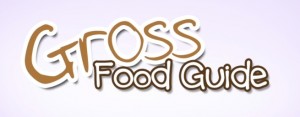How do you keep people interested in a crowdfunding project throughout the campaign? That’s the question anyone looking to maintain momentum through a 30 or 40-day fundraising cycle must ask themselves.
As any creative agency will attest, coming up with a cool creative idea is the easy part. Keep it interesting and relevant through the duration of the campaign is the hard part. In many ways crowdfunding is very similar to running an advertising/marketing campaign. The main difference being that most people who put their hopes in crowdfunding are not marketing or advertising professionals.
Neither am I for that matter but I do have a good deal of experience in shaping content plans and creating content to support campaigns and longer term initiatives. And with my crowdfunding project - The Gross Food Guide - I knew that a strong, regular mix of supporting content was going to be crucial to draw attention to the campaign because, unlike, many crowdfunded projects, The Gross Food Guide, didn’t exist before the Indiegogo campaign.
That, in itself has proved a bit of a handicap…but I’ll keep the lessons learned from trying to launch a brand through crowdfunding for another column. However, in order to build interest in The Gross Food Guide for 40 straight days, I needed to have a solid content/editorial plan and a connected social media outreach strategy. Here’s what I created and why I did it.
1, Know Your Audience
The Gross Food Guide is an App for kids aged 6 - 10 but most kids that age aren’t actively involved in social media (the odd YouTube video aside) and, anyway, I don’t have an App to show them yet. The more important audience at this stage of the venture are the parents who would likely contribute to fund the project and hence purchase an advance copy of the App. The second main audience is people interested in crowdfunding as well as people interested in food in general.
2, Know where they like to get their information
Reaching the right audience with interesting information about The Gross Food Guide isn’t as simple as creating a cool video or writing a few blog posts and hoping people will discover them. You have to know exactly where and how your potential audience/funders like to get their information. Before launching the campaign I commissioned a piece of research - sometimes called an influencer map - to highlight 200 blogs and Twitter accounts dedicated to parenting, kids food, kids apps and crowdfunding. That way I was able to target the main audience for The Gross Food Guide and then create content that would appeal to them.
3, Planning and Creating Content
Based on the work I’d done creating a prototype for The Gross Food Guide I already had a wealth of content that I could write and package for the campaign. Ahead of launching the campaign I created a 40-day content map and scheduled a blog post each day devoted to a different type of “gross food”. That would provide the content backbone for the campaign and ensure I had a new piece of content every single day.
Next I created this Crowdfunding diary for SMI readers who might not be parents or care about food but may well be interested in the inner workings of a crowdfunding. By writing this “diary” throughout the campaign I can raise additional awareness for The Gross Food Guide and also, in full candour, do some of the primary research required for the SMI Guide to Crowdfunding that I’ll publish after the campaign is finished (and which is being offered as one of the perks for contributing to the campaign). In this way I’m using content to fuel interest in the project but also create a secondary project that will have value even after the campaign has ended.
Both the diary and the 40 days of blog posts provide steady social media editorial content. But, to generate interest for a concept no-one had hear of 20 days ago and which only has 20 more days of fundraising to go, I needed a “story” that could grab attention and cut through the noise of so much online chatter.
That’s why I created The Gross Food Global Challenge - a Facebook poll where people can choose from the 20 grossest dishes and vote for the one they considered the grossest. The dish with the most votes will be included as a special reader’s choice in The Gross Food Guide App. And to accompany the challenge I built a ‘global tour” of Gross Foods in Prezi - the type of shareable content that might generate a buzz for the fundraising campaign.
Next time I’ll discuss the social media outreach for all this content.




